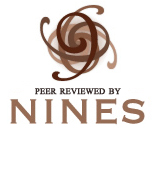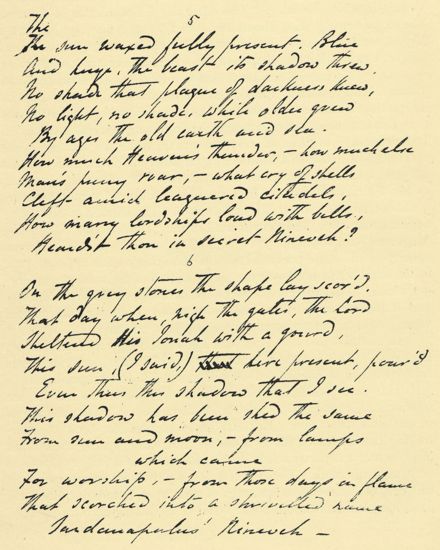NINES Peer-Reviewed Essays content in NINES is protected by a Creative Commons License.

D.G. Rossetti’s “The Burden of Nineveh”: Further Excavations
Pages:
«Previous page
1Page 1
2Page 2
You are here 3Page 3 4Page 4 5Page 5 EndmatterEndmatter »Next page
You are here 3Page 3 4Page 4 5Page 5 EndmatterEndmatter »Next page
535
Rossetti most likely began writing “The Burden of Nineveh” in October
or November of 1850, shortly after the enormous Assyrian bull
bas-relief arrived in London.@On the poem's composition, see The P.R.B. Journal, 82; and W.M. Rossetti's Dante Gabriel Rossetti as Designer and Writer, 137-38 (cited from the Rossetti Archive). The story of the monument's arrival in London can be found in Bohrer, 125ff. See also Malley, Jenkins, 155ff.; and Gadd, 124-27 and 159-60. It has been thought that no record of the
poem at this earliest stage survives. However, as a search in the
Rossetti Archive reveals, we do have two stanzas (numbered 5 and 6) of
what appears to be an 1850 fair-copy manuscript (now lost), preserved
in facsimile in H.C. Marillier's Dante Gabriel Rossetti, An Illustrated
Memorial of his Life and Art (1899; cited from the Rossetti Archive). In
addition, Marillier reproduces a second manuscript fragment (of stanza
7), which he dates somewhat later, but prior to the poem’s first
publication in 1856 in the Oxford and Cambridge Magazine, the point at
which scholars have thought the trail begins. These texts, our earliest
witnesses to the poem, were recorded only through a stroke of luck:
Marillier chose to reproduce pages from the two manuscripts of “The
Burden of Nineveh” as examples of the changes in Rossetti’s handwriting
between 1850 and 1856. He writes,
it may be worthwhile to include
some specimens of Rossetti's handwriting at different dates, and for
this purpose I have selected three examples from the collection
belonging to Mr. Fairfax Murray. These are, first, a couple of verses,
numbers 5 and 6, from the earliest original draft of “The Burden of
Nineveh”, begun about 1850, and first printed in the “Oxford and
Cambridge Magazine” in 1856 (pp. 771-775). The second specimen is from
verse 7 of the same poem, a later interpolation on the opposite page of
the manuscript book—or the blank portion of the same page, I forget
which. The difference between the two styles is quite perceptible, and
if the earlier portion dates from about 1850, the interpolated verse
would belong to some succeeding year not later than 1856. (221)
The
arbitrary choice of these pages has led to their survival, since this
particular manuscript book of Fairfax Murray’s is untraced.@Perhaps they were once part of the notebook headed “Lyrics &c.” now in the Troxell collection: http://www.rossettiarchive.org/docs/lyrics.prinms.radheader.html. In any case, Marillier suggests that they were part of a book that Fairfax Murray had assembled himself, in a format similar to “Lyrics &c.” Whether Marillier removed them from the book in order to make his reproductions is likely but uncertain. Perhaps this ‘stroke of luck’ was in fact from a double-edged sword, since the loss of the notebook may have stemmed from Marillier’s handling of it. The dating
and relationship of the two specimens is presumably conjectural
(Marillier’s third example is a manuscript of “Adieu,” written circa
1880). As Marillier indicates, the “Burden of Nineveh” manuscripts
offer early examples of Rossetti’s handwriting, and it seems that these
manuscripts represent comparatively early stages in the poem’s
evolution (prior to its 1856 publication), since the readings they
contain do not recur in any of the later texts.
The verses Marillier presents from the 1850 fair-copy are free of revisions except for three corrections that must be original to the manuscript’s transcription (i.e., they are not later alterations, but running corrections of the lines). The following is the text of the first Marillier manuscript (see figure 1):
5.
The The sun waxed fully present. Blue
And huge, the beast its shadow threw.
No shade that plague of darkness knew,
No light, no shade, while older grew
By ages the old earth and sea.
How much Heaven’s thunder, -- how much else
Man’s puny roar, -- what cry of shells
Cleft amid leaguered citadels,
How many lordships loud with bells,
Heards’t thou in secret Nineveh?
6
On the grey stones the shape lay scor’d,
That day when, nigh the gates, the Lord
Sheltered h His Jonah with a gourd,
This sun, (I said,) that here present, pour’d
Even thus this shadow that I see.
This shadow has been shed the same
From sun and moon, -- from lamps which came
For worship, -- from those days in flame
That scorched into a shrivelled name
Sardanapalus’ Nineveh –
The The sun waxed fully present. Blue
And huge, the beast its shadow threw.
No shade that plague of darkness knew,
No light, no shade, while older grew
By ages the old earth and sea.
How much Heaven’s thunder, -- how much else
Man’s puny roar, -- what cry of shells
Cleft amid leaguered citadels,
How many lordships loud with bells,
Heards’t thou in secret Nineveh?
6
On the grey stones the shape lay scor’d,
That day when, nigh the gates, the Lord
Sheltered h His Jonah with a gourd,
This sun, (I said,) that here present, pour’d
Even thus this shadow that I see.
This shadow has been shed the same
From sun and moon, -- from lamps which came
For worship, -- from those days in flame
That scorched into a shrivelled name
Sardanapalus’ Nineveh –
As I have mentioned and will discuss shortly, these 1850 readings were substantially altered prior to the poem’s first publication. In addition, the stanza numbering is off: these lines are closest in content to stanzas 3 and 4 of the Oxford and Cambridge Magazine version (not 5 and 6), indicating a cancellation in manuscript. Furthermore, Rossetti added a stanza during the 1869 revisions – resuscitating the one deleted prior to 1856 and working from a manuscript very like the one that Marillier saw – so these numbers do square with those of the received text after 1870. That is, the apparently-belated 1869 addition is in fact a reinsertion of lines from the very early 1850 version. In the 1869 Penkill proofs, Rossetti added the following verses as the new 4th stanza, carried forward virtually unchanged into the first edition of the 1870 Poems:
Oh when upon each sculptured court,
Where even the wind might not resort,—
O’er which Time passed, of like import
With the wild Arab boys at sport,—
A living face looked in to see:—
Oh seemed it not—the spell once broke!—
As though the carven warriors woke,
As though the shaft the string forsook,
The cymbals clashed, the chariots shook,
And there was life in Nineveh?
(Penkill proofs, manuscript insertion, page 14a)
Where even the wind might not resort,—
O’er which Time passed, of like import
With the wild Arab boys at sport,—
A living face looked in to see:—
Oh seemed it not—the spell once broke!—
As though the carven warriors woke,
As though the shaft the string forsook,
The cymbals clashed, the chariots shook,
And there was life in Nineveh?
(Penkill proofs, manuscript insertion, page 14a)
The second half of this stanza (“Oh seemed it not…”) was already present in the 1856 Oxford/Cambridge version, where it was fused with the first half of stanza 5 in the newly-discovered 1850 Marillier MS. This is the Oxford/Cambridge stanza (cited from the Rossetti Archive):
On London stones our sun anew
The beast’s recover’d shadow threw.
No shade that plague of darkness knew,
No light, no shade, while older grew
By ages the old earth and sea.
Oh! seem’d it not—that spell once broke,
As though the sculptured warriors woke,
As though the shaft the string forsook,
The cymbals clash'd, the chariots shook,
And there was life in Nineveh?
The beast’s recover’d shadow threw.
No shade that plague of darkness knew,
No light, no shade, while older grew
By ages the old earth and sea.
Oh! seem’d it not—that spell once broke,
As though the sculptured warriors woke,
As though the shaft the string forsook,
The cymbals clash'd, the chariots shook,
And there was life in Nineveh?
In other words, in preparing the poem for its first publication in 1856, Rossetti combined stanzas 4 and 5 from the 1850 version, judiciously cutting the clichéd and anachronistic section on “Heaven’s thunder,” “the cry of shells” and “lordships loud with bells…in secret Nineveh.” He also eliminated the dangling modifier in lines 2-3; “Blue and huge” seems meant to describe the shadow, not the “beast” itself.


